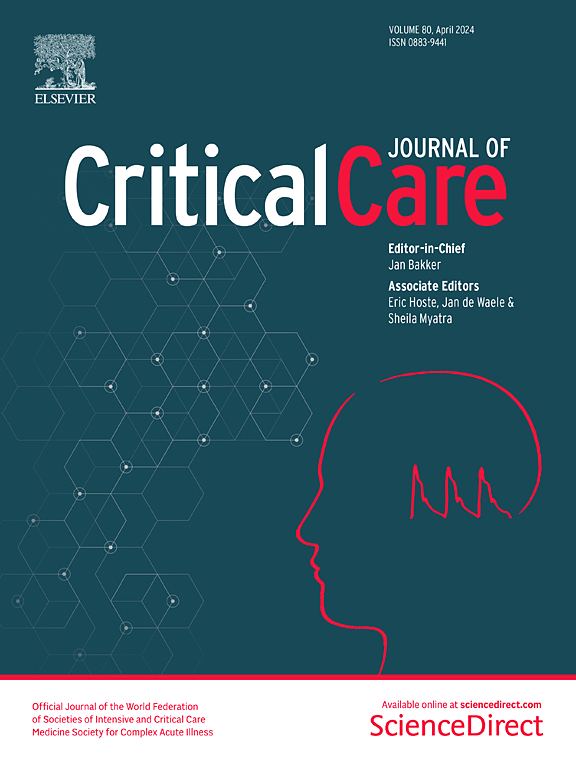静脉-静脉体外膜氧合脱管后血细胞回收对输血需求的影响:一项模拟试验分析
IF 8.8
1区 医学
Q1 CRITICAL CARE MEDICINE
引用次数: 0
摘要
静脉-静脉体外膜氧合(VV-ECMO)是一种支持治疗急性呼吸衰竭与填充红细胞(PRBC)输血的风险增加。血细胞回收(Blood cell salvage, BCS)旨在减少输血,但其效果尚不清楚。本研究旨在评估去除ECMO回路(ECMO脱管)时BCS对PRBC输注的影响。为了比较BCS和非血细胞挽救(n-BCS),我们在英国的两个ECMO中心对患者进行了模拟试验。我们使用治疗加权逆倾向来控制混淆,并估计BCS对脱管后两天内输注的PRBC的平均治疗效果,以及对血红蛋白(Hb)变化的影响。我们纳入了841例接受VV-ECMO脱管的患者。使用BCS时估计的PRBC边际平均输注数为0.2 (95%CI: 0.16, 0.25)个单位,而使用n-BCS时为0.51 (95%CI: 0.44, 0.59)个单位;平均治疗效果为- 0.31 (95%CI: - 0.40, - 0.22)个单位。BCS将接受任何PRBC输血的风险降低了17.1% (95%CI: 11.1%, 22.9%),相当于任何PRBC输血所需治疗的6个数字(95%CI: 5,9)。BCS和n-BCS在脱管后的预期Hb水平差异为5.0 (95%CI: 4.2, 5.8) g/L。在VV-ECMO脱管期间使用BCS可能是增加血红蛋白水平和减少PRBC输注的有效策略。本文章由计算机程序翻译,如有差异,请以英文原文为准。
The effects of blood cell salvage on transfusion requirements after decannulation from veno-venous extracorporeal membrane oxygenation: an emulated trial analysis
Veno-venous extracorporeal membrane oxygenation (VV-ECMO) is a supportive therapy for acute respiratory failure with increased risk of packed red blood cells (PRBC) transfusion. Blood cell salvage (BCS) aims to reduce blood transfusion, but its efficacy is unclear. This study aimed to estimate the effect of BCS at the time of removal of the ECMO circuit (ECMO decannulation) on PRBC transfused. To compare BCS to non-blood cell salvage (n-BCS), we conducted an emulated trial of patients at two ECMO centres in the United Kingdom. We used inverse propensity of treatment weighting to control for confounding and estimated the average treatment effect of BCS on PRBC transfused within two days of decannulation, and on changes in haemoglobin (Hb). We included 841 patients who underwent VV-ECMO decannulation. The estimated marginal mean number of PRBC transfused when using BCS was 0·2 (95%CI: 0·16, 0·25) units compared to 0·51 (95%CI: 0·44, 0·59) units with n-BCS; an average treatment effect of −0·31 (95%CI: −0·40, −0·22) units. BCS reduced the risk of receiving any PRBC transfusion by 17·1% (95%CI: 11·1%, 22·9%) equating to a number needed to treat for any PRBC transfusion of 6 (95%CI: 5, 9). The difference in expected Hb levels after decannulation between BCS and n-BCS was 5·0 (95%CI: 4·2, 5·8) g/L. The use of BCS during VV-ECMO decannulation may be an effective strategy to augment haemoglobin levels and reduce PRBC transfusions.
求助全文
通过发布文献求助,成功后即可免费获取论文全文。
去求助
来源期刊

Critical Care
医学-危重病医学
CiteScore
20.60
自引率
3.30%
发文量
348
审稿时长
1.5 months
期刊介绍:
Critical Care is an esteemed international medical journal that undergoes a rigorous peer-review process to maintain its high quality standards. Its primary objective is to enhance the healthcare services offered to critically ill patients. To achieve this, the journal focuses on gathering, exchanging, disseminating, and endorsing evidence-based information that is highly relevant to intensivists. By doing so, Critical Care seeks to provide a thorough and inclusive examination of the intensive care field.
 求助内容:
求助内容: 应助结果提醒方式:
应助结果提醒方式:


